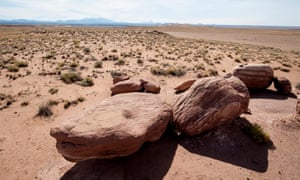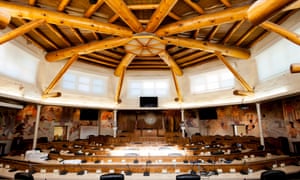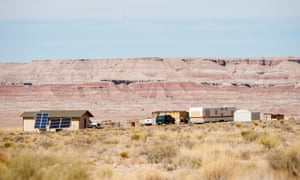It’s been two years since Sonia’s husband’s fatal heart attack. Almost anywhere else in the United States, emergency services could have helped her. But in an isolated corner of the 27,000 square miles that constitute the Navajo Nation, she, her daughter and one of her granddaughters had to manage without technology most of the rest of America takes for granted.
The family were outside Tolani Lake, in part of the vast Navajo Nation’s land in north-east Arizona. “My husband had roped a bull that we were dealing with,” Sonia said. “He said he needed to catch his breath. I told him to sit down and he did.” He started to feel better, got back to work and then faltered again.
“We were taking him over to the truck,” Sonia recalls, “but he knelt down.” Sonia’s daughter called 911.
Across the vast majority of the United States – almost 99% of the country – 911 callers can be traced directly to their cellphone’s latitude and longitude, enough information to send help by air. But not here.
Sonia, who asked that the Guardian not use her full name or the names of her family, tried to describe their surroundings, but the dispatcher in Leupp, Arizona, 20 miles away, was unfamiliar with the area. And there was no information from their phones.
The dispatcher asked the family to come to the nearest road.
Three generations of Sonia’s family carried the older man between them across the patch of desert between the livestock and the truck. They put him in the back and drove. A fire truck met them at the top of a hill closer to the main road. Eventually an ambulance arrived and drove to Leupp across dry miles of unpaved road, where cars fishtail and spin out if they try to hurry.
In Leupp, the vital helicopter was waiting, but by then it was too late.
Sonia said she’s made her peace with it. “He probably didn’t want to live after that. He doesn’t want to be at home not doing anything,” she said, her voice breaking. “He likes to be out there and he’d have to put up with that. So it’s OK with me. Even if we’d got him going again, he wouldn’t have wanted to be there.”
‘After a while, people just stop calling’
In many rural communities in the US, the low population density means that phone and internet companies simply don’t upgrade their equipment often enough to keep pace with progress. In Navajo, much of the vital infrastructure was never installed to begin with.
Large stretches of the Navajo Nation, a sovereign state larger than 10 of the 50 states in the US, look like the surface of some other, beautiful planet. Sometimes the landscape is nothing but red dirt, orange rock, striations of yellow and white streaking the faces of cliffs and the cross-sections of buttes beside paved roads that have been blasted through those hills or unpaved roads that dip suddenly into dry creek beds. Locals replace their tires a lot. Dust devils rear up to the height of two-storey houses, staining the blue sky with a boiling tan streak.
Most of what moves, besides cars, is tumbleweed, dry clusters and strands of which stick to fences, meander from patch to patch of grass and get caught far above the ground in the unshielded silver wires strung between the telephone poles that run alongside the highway.
Those wires are the thin filament that connect places like To’hajilee, a reservation of about 4,000 people to the outside world. In large parts cellphone coverage is spotty – at best. There is no broadband. In February, a break in the community’s sole line meant that none of the ATMs or credit card scanners in town worked.
Navajo is the largest recipient of funds from the US Bureau of Indian Affairs – it’s the most populous tribe in the country – but the figures themselves can be insultingly low. A 2014 grant to Navajo’s state-owned internet provider, which aspires to serve the community of 300,000 across an area larger than West Virginia, totaled some $32m. AT&T of Tennessee received $156m in federal money to provide broadband access to 81,000 homes in rural Tennessee the following year.
Cell coverage is a patchwork; even on the larger networks like Verizon, data connection is unreliable. Wired connections are, if anything, worse. The consequences of an economy trapped in the previous century are depressingly predictable.
“We have very violent, lawless communities,” said Gina Begay-Roanhorse, who works at the courthouse in To’hajilee, an “island” reservation surrounded on all sides by non-Navajo land, some Pueblo, some New Mexico. “I’m not afraid to say it anymore.” As in much of America, opioid addiction is epidemic. Mental illness and domestic violence go under-addressed.
The tribal police communicate using radio; when they can’t run a plate by calling it in, they have to use their own phones, at their own expense, as cellular hotspots for the laptops they keep in their cars.
On average, Navajo police are responsible for 100 square miles apiece.
Wired phone service is unreliable: first responders at the scene of an accident in To’hajilee will often call call the local emergency clinic directly, rather than calling 911. Even then, sometimes callers hear only ringing and ringing, said Fitisha Baca, who works as an emergency medical technician in To’hajilee with her sister Racquel. “After a while, people just stop calling,” Begay-Roanhorse said.




No hay comentarios:
Publicar un comentario